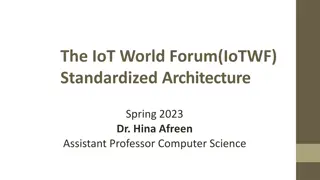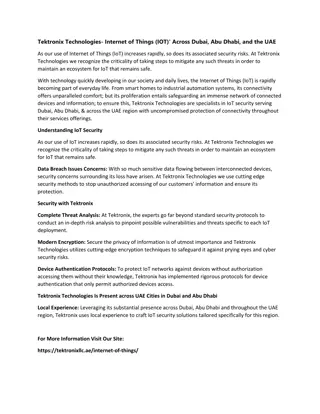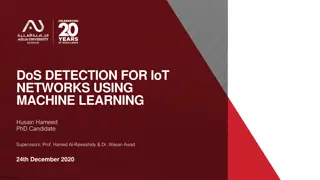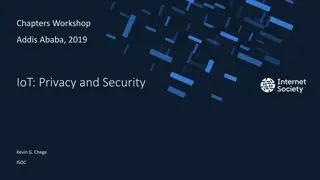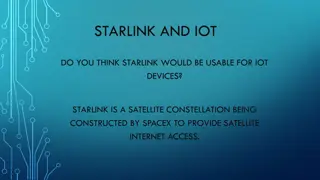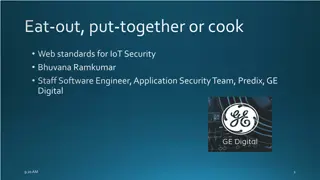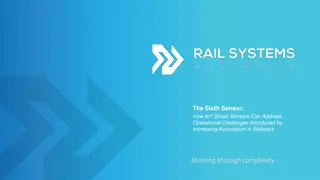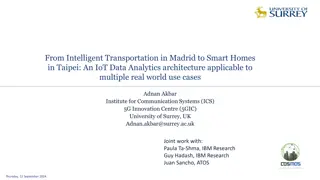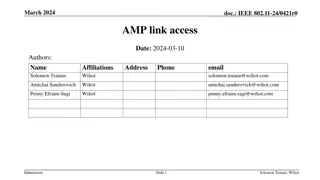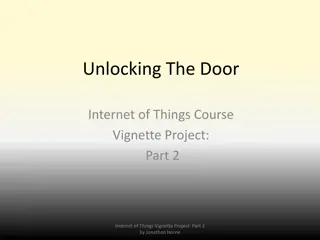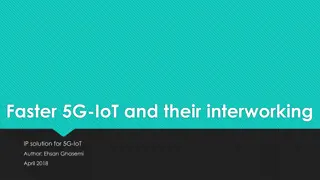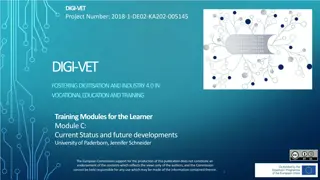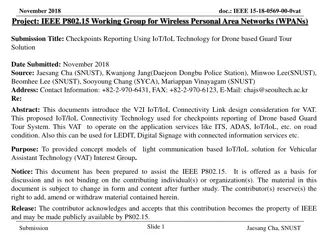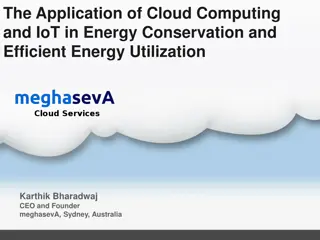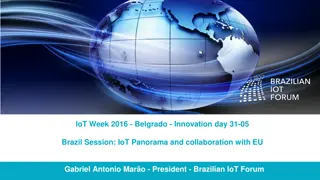
Implementing Medium Access Control for IoT Devices in IEEE 802.11-23
Explore the consensus on medium access control for AMP-only IoT devices in IEEE 802.11-23 standards. Understand the strategies to enhance power management and simplify MAC protocols for efficient IoT operations. Discover the specified AP-driven medium access mechanisms and the challenges in implementing them for IoT devices.
Download Presentation

Please find below an Image/Link to download the presentation.
The content on the website is provided AS IS for your information and personal use only. It may not be sold, licensed, or shared on other websites without obtaining consent from the author. If you encounter any issues during the download, it is possible that the publisher has removed the file from their server.
You are allowed to download the files provided on this website for personal or commercial use, subject to the condition that they are used lawfully. All files are the property of their respective owners.
The content on the website is provided AS IS for your information and personal use only. It may not be sold, licensed, or shared on other websites without obtaining consent from the author.
E N D
Presentation Transcript
May 2023 doc.: IEEE 802.11-23/0827r0 AMP IoT Medium Access Date: 2023-05-15 Authors: Name Sebastian Max Affiliations Address Ericsson GmbH Phone email sebastian.max@ericsson.com Ericsson Allee 1 52134 Herzogenrath Germany charlie.pettersson@ericsson.com Charlie Pettersson Leif Wilhelmsson Guido R. Hiertz Ericsson AB leif.r.wilhelmsson@ericsson.com Ericsson AB hiertz@ieee.org Ericsson GmbH Submission Slide 1 Sebastian Max, Ericsson GmbH
May 2023 doc.: IEEE 802.11-23/0827r0 AMP Medium Access Control Consensus Straw Poll from [1]: Simplified MAC (on top of existing WLAN technologies) + Enhanced power saving/power management Consider frequency bands of Sub-1 GHz and 2.4 GHz Question: How to implement medium access in AMP-only IoT devices? Listen-before-Talk consumes significant power [3] AP-driven medium access necessary to limit power consumption of AMP-only IoT devices Which types of AP-driven medium access mechanisms are already specified? Submission Slide 2 Sebastian Max, Ericsson GmbH
May 2023 doc.: IEEE 802.11-23/0827r0 Type 1: HT Reverse Direction Protocol Backoff RD initiator final PPDU RD initiator PPDU + RD grant RD response burst RD responder TXOP TXOP owner sends Reverse Direction (RD) grant in PPDU TXOP owner denoted as RD initiator RD responder sends one or more PPDUs as response RD initiator finishes RD grant Multiple RD grants per TXOP to different STAs possible Submission Slide 3 Sebastian Max, Ericsson GmbH
May 2023 doc.: IEEE 802.11-23/0827r0 Type 2: S1G Bidirectional TXOP (more data = 1) (more data =0) PS-Poll + BDT BlockAck Data/Poll Data/Poll (more data = 1) (more data = 1) (more data =0) Data Data Data 1st sequence 2nd sequence 3rd sequence TXOP Extension of RDP to multiple sequences Separated by SIFS Inspired by Polling mechanisms in obsolete Point Coordination Function Submission Slide 4 Sebastian Max, Ericsson GmbH
May 2023 doc.: IEEE 802.11-23/0827r0 Type 3: EHT Triggered TXOP Sharing Backoff Block Ack MU-RTS TXS Trigger EHT AP Data to AP in non-TB PPDU CTS EHT non-AP STA Time allocated in MU-RTS TXS TF TXOP Initiated by a MU-RTS TXS trigger frame Only one User Info field, addressed to an associated non-AP STA Allocates time for uplink data Submission Slide 5 Sebastian Max, Ericsson GmbH
May 2023 doc.: IEEE 802.11-23/0827r0 Type 4: HE Triggered Uplink Backoff MU- Basic Trigger Frame HE AP BlockAck Data to AP in TB PPDU P HE non-AP STA1 P HE non-AP STA2 Data to AP in TB PPDU Time allocated in Basic TF TXOP Initiated by Basic TF Containing common & user-specific info (time allocated, RU allocation, transmission parameters, ...) Supports Multi-user aggregation Random access procedure (UORA) Submission Slide 6 Sebastian Max, Ericsson GmbH
May 2023 doc.: IEEE 802.11-23/0827r0 AP-Driven Random Access Random access is required for unknown AMP devices E. g., initial identification of the device Question: How to realize AP-driven random access? AP signals a set of resources AMP device selects one of the resources randomly and transmits AP replies with success/failure status Assumption: AMP devices cannot do LBT or channel sensing Submission Slide 7 Sebastian Max, Ericsson GmbH
May 2023 doc.: IEEE 802.11-23/0827r0 Type 1: Random access in time Similar to random access procedure known from RFID [4] Add random access to Bidirectional TXOP Backoff (BO) is also controlled by the AP, using BO counter frames and PIFS to wait for reply PS-Poll + BDT + CW: 0...15 ACK, 6? 1? 2? 0? PIFS PIFS PIFS SIFS SIFS AP AMP-only IoT device Draw 2 Data Submission Slide 8 Sebastian Max, Ericsson GmbH
May 2023 doc.: IEEE 802.11-23/0827r0 Type 2: Random access in frequency Use random access procedure of HE Triggered Uplink UORA: RUs are dedicated for random access by AP, STA selects RU randomly Trigger Frame ACK SIFS SIFS AP AMP-only IoT device Draw 2 Data Submission Slide 9 Sebastian Max, Ericsson GmbH
May 2023 doc.: IEEE 802.11-23/0827r0 Strawpoll Do you agree to define a medium access method for AMP WLAN that bases on the principles of HE Triggered Uplink? Details are TBD Y / N / A Notes: Details are, for example, How the AP signals duration, frequency resources, transmit parameters, etc... in a trigger frame How the AMP STAs select and reply in separate frequency resources UORA-like random-access procedure Submission Slide 10 Sebastian Max, Ericsson GmbH
May 2023 doc.: IEEE 802.11-23/0827r0 References [1] Yinan Qi et al., Proposal for consensus straw poll and motion, IEEE 802.11 submission 11-23/0406r1 [2] Weijie Xu et al., Technical Report on support of AMP IoT devices in WLAN, IEEE 802.11 submission 11-23/0436r0 [3] Xiaogang Chen et al., Low Power Listening Mode, IEEE 802.11 submission 11-22/1414r1 [4] GS1, EPC Radio-Frequency Identity Protocols Generation-2 UHF RFID Standard, Release 2.1, Jul., 2018 Submission Slide 11 Sebastian Max, Ericsson GmbH

